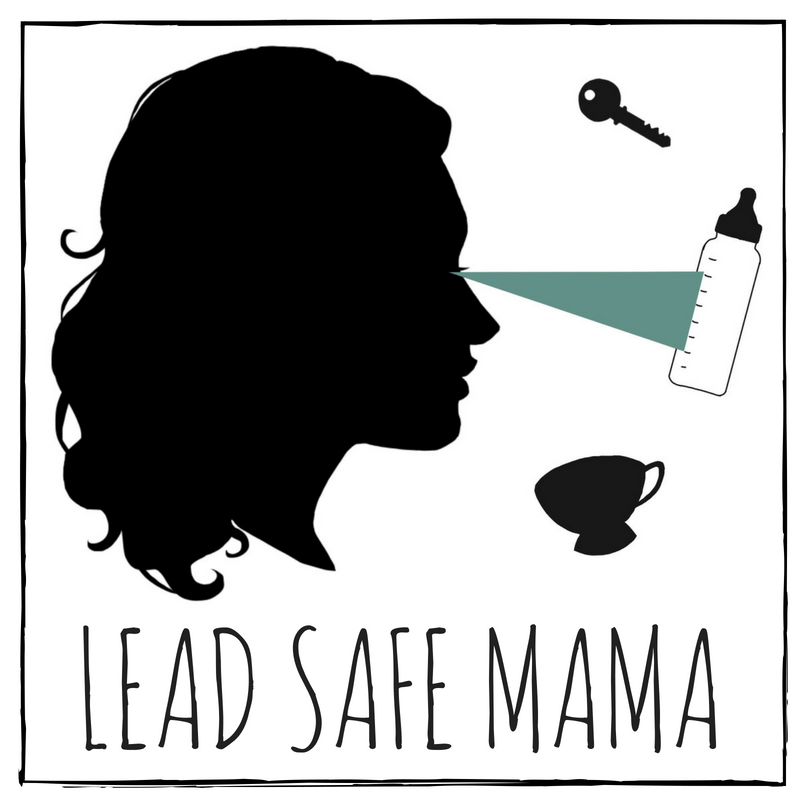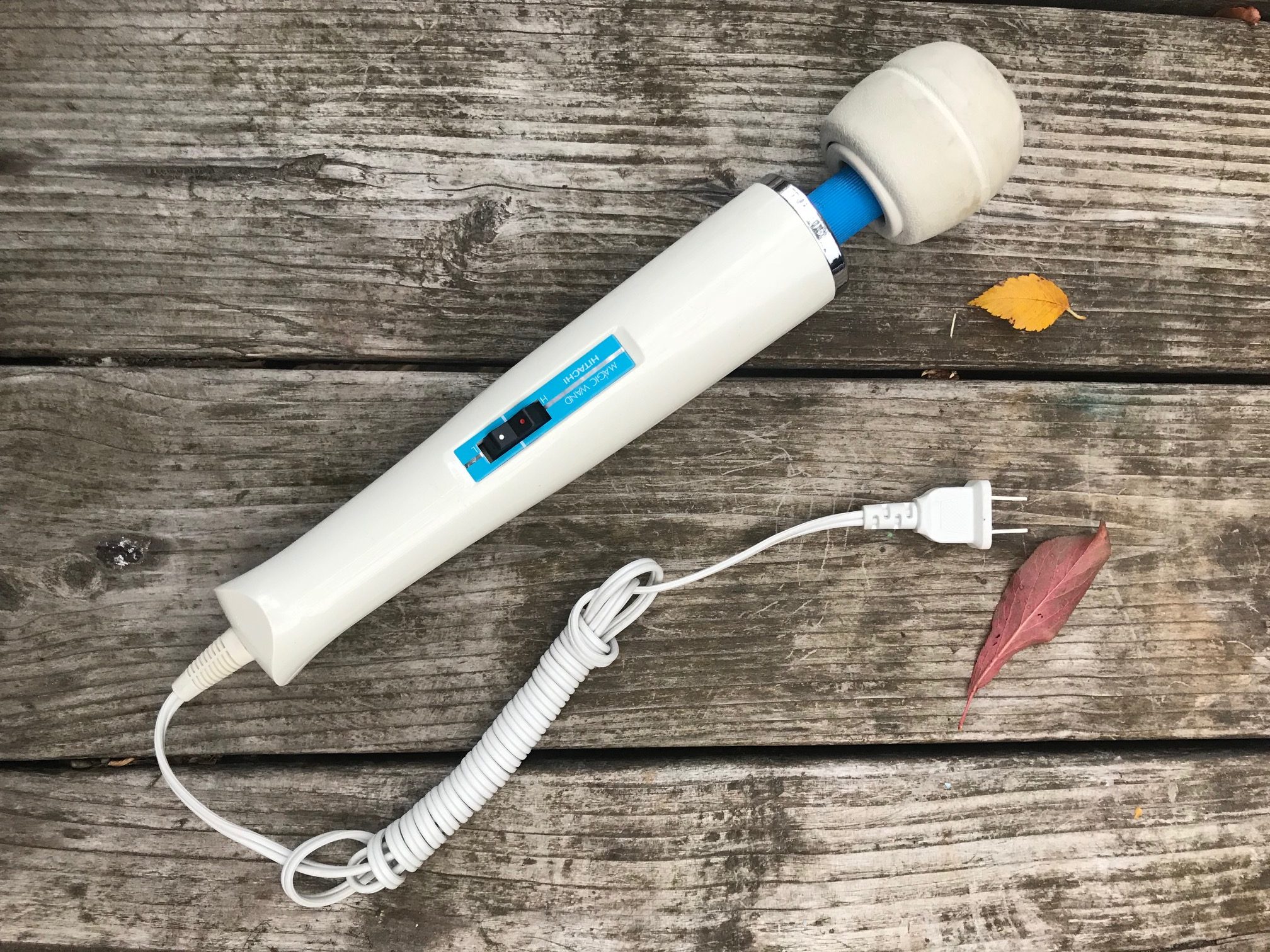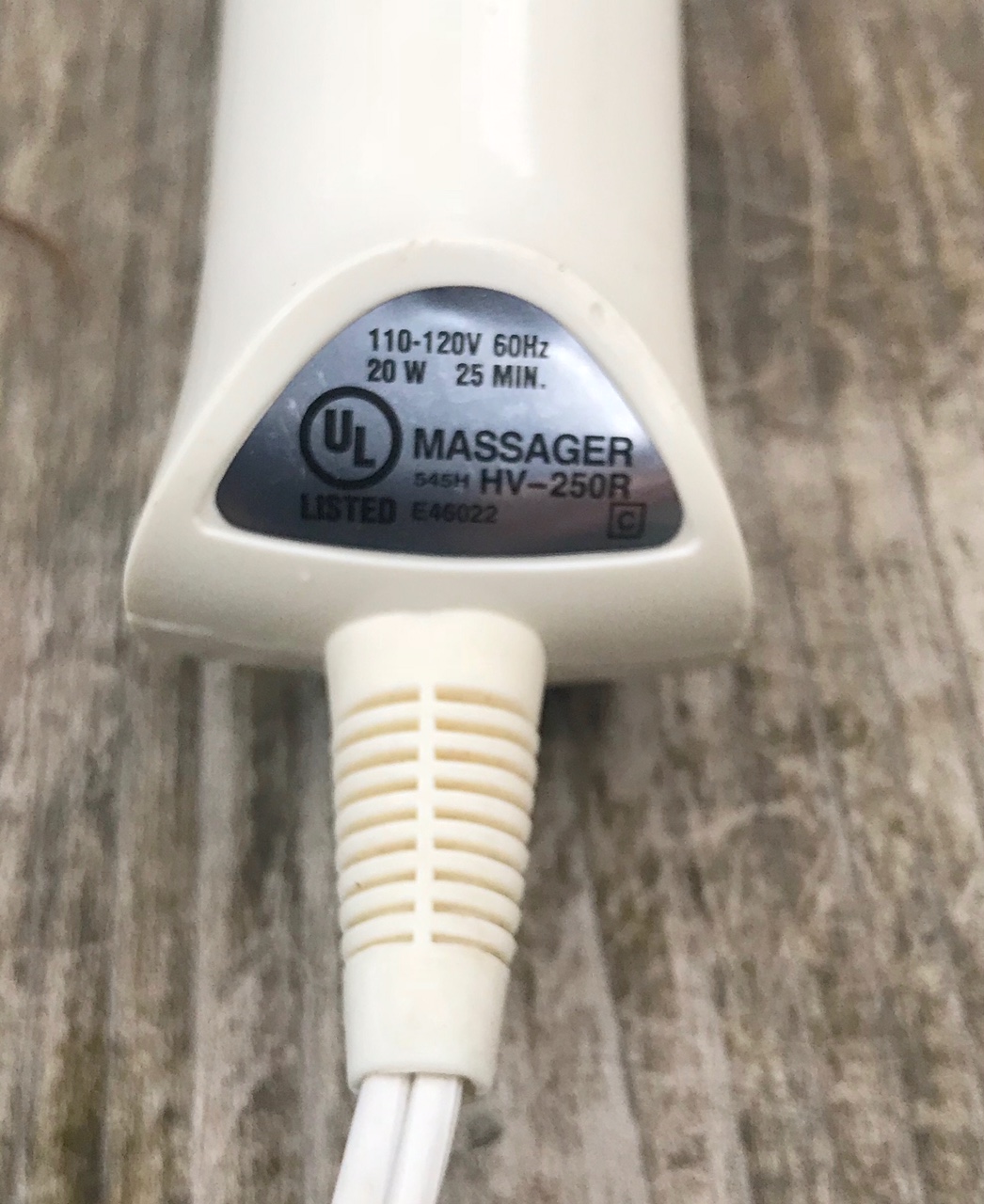#AskTamara: Are There Toxic Chemicals in my Hitachi “Magic Wand” Personal Massager/Vibrator?
Question: Are there toxic chemicals in my Hitachi “Magic Wand” personal massager/vibrator?
Answer: Well, as a matter of fact, now that you ask, there were concerning levels of ANTIMONY (Sb) in the Magic Wand personal massager by Hitachi that I recently tested.
Please note: I only tested ONE example of this product and this one was purchased new from a store approximately 10 years ago (c. 2008). Newer wands from this company, when tested with an XRF instrument, may not have the same high levels of this toxicant — or contain any, for that matter; on the other hand, it’s also possible that older ones (apparently these have been popular for more than 30 years now!) might test positive for other heavy metals, which the version I tested did not test positive for. So, although in my experience, random samples of mass-manufactured items like this from a major manufacturer can often constitute a meaningful snapshot of production at that time, take this for what it is — just a single, non-current sample of this item!
The full XRF test results for the massager pictured here are below the image, however, please continue reading to the end of this piece for more information and considerations!
White Electrical Cord:
- ND for Pb, As, Hg & Cd
- Barium (Ba): 153 +/- 50 ppm
- Antimony (Sb): 2,494 +/- 49 ppm
- Bromine (Br): 365 +/- 14 ppm
- Zinc (Zn): 865 +/- 44 ppm
- Copper (Cu): 518 +/- 45 ppm
- Iron (Fe): 160 +/- 59 ppm
- Titanium (Ti): 5,549 +/- 1,392 ppm
The White Hard Plastic Body of the Wand:
- ND for Pb, Hg & Cd
- Arsenic (As): 72 +/- 39 ppm
- Antimony (Sb): 31,700 +/- 2,100 ppm
- Bromine (Br): 138,900 +/- 8,900 ppm
- Zinc (Zn): 142 +/- 42 ppm
- Vanadium (V): 1,246 +/- 518 ppm
- Titanium (Ti): 5,224 +/- 1,162
A second longer test of this component confirmed these levels:
- Arsenic (As): 72 +/- 27 ppm
- Antimony (Sb): 33,900 +/- 1,600 ppm
Silver Colored Collar/ Band:
- ND for Pb, As, Hg & Cd
- Chromium (Cr): 17,600 +/- 900 ppm
- Bromine (Br): 281 +/- 56 ppm
- Gold (Au): 1,039 +/- 384 ppm
- Copper (Cu): 688,100 +/- 2,500 ppm
- Nickel (Ni): 290,300 +/- 2,300 ppm
“Rubber” Massage Ball end:
- ND for Pb, As, Hg & Cd
- Barium (Ba): 252 +/- 48 ppm
- Tin (Sn): 480 +/- 19 ppm
- Zinc (Zn): 545 +/- 35 ppm
- Iron (Fe): 463 +/- 70 ppm
- Titanium (Ti): 6,058 +/- 1,411 ppm
Why is Antimony (Sb) a problem?
While I cannot say that antimony in sex toys will necessarily harm you, antimony has been documented to be potentially carcinogenic to humans (and at least capable of poisoning humans leading to other health impacts similar to arsenic poisoning, if not causing cancer specifically).
As a result, I think it is prudent to advocate that antimony not be allowed in sex toys under the “first do no harm” principle — especially and specifically for professions (and products) that are assumed to be providing a health benefit.
Some studies and links about antimony:
- Wikipedia: “antimony trioxide is potentially carcinogenic to humans” — https://en.wikipedia.org/wiki/Antimony
- “…antimony trioxide and antimony trisulfide have been seen to cause lung tumours in rats. Antimony trioxide is classified as possibly carcinogenic to humans (Group 2B) by the International Agency for Research on Cancer” — https://www.ncbi.nlm.nih.gov/pmc/articles/PMC3037053/
- “Antimony poisoning, harmful effects upon body tissues and functions of ingesting or inhaling certain compounds of antimony. Such poisoning resembles arsenic poisoning” — https://www.britannica.com/science/antimony-poisoning
- From 2011: “Antimony (Sb) is a toxic trace element widely distributed in the lithosphere and mainly associated with arsenic. Sb compounds are considered to be pollutants of high interest, however, the biogeochemical behaviour of Sb is still largely unknown, especially compared to other well-known toxic elements” — https://www.sciencedirect.com/science/article/pii/S0375674210001081
Who else knows about/ has shared any concern for toxic chemicals in sex toys?
In writing this article I did a little research regarding toxicity concerns in sex toys and discovered several other pieces have been written on the subject (some of these even actually discuss the presence of ANTIMONY in sex toys — as discussed in a 2006 study done in Denmark). However, I could not find a study that discussed any concerns (or lack of concerns) for the potential migration of antimony during the normal and intended use of these products (studying migration would note if the antimony is absorbed by — or even available to — the human body during the course of normal use).
Check out the following articles and links about concerns for toxicity in sex toys:
- From 2006, yet another reason to love Denmark (progressive thinking and science): https://www2.mst.dk/udgiv/publications/2006/87-7052-227-8/pdf/87-7052-228-6.pdf
- From 2017: https://www.dailymail.co.uk/femail/article-4381166/Why-sex-toys-exposing-people-harmful-chemicals.html
- From 2016: http://mysecretsoiree.com/blog/2016/02/25/when-sex-toys-go-wrong-a-tale-of-toxic-sex-toys/
- From 2015: http://erikalynae.com/2015/01/31/toxic-sex-toys/
- From 2008: https://thebottomline.as.ucsb.edu/2008/03/phthalates-the-toxic-chemicals-that-might-be-in-your-sex-toy-by-lynnea-dally
- Here’s an interesting piece from 2017: https://www.inverse.com/article/30641-sex-toys-testing-regulations
- Here’s yet another good one… this is a very interesting rabbit hole to go down (in terms of all of the articles one could read!): https://broadly.vice.com/en_us/article/bj5bqv/how-to-tell-if-your-sex-toy-is-toxic
- Here’s a whole site about toxicity in sex toys: http://dangerouslilly.com/toxictoys/
So it looks like manufacturers and regulatory agencies have known about these concerns for at least 12 years (at least in Denmark), yet I don’t know that anything is being done about it in the United States.
The main problem (which is mentioned in several of the articles linked above) is that these toys are not regulated strictly — like food, medicine or medical devices might be — but instead fall under the loophole of being a “novelty product,” which (in the United States) makes them subject to pretty much no regulatory standards when it comes to toxicity concerns and other potential related health complications that might arise from using one of these items.
As always, thank you for reading and sharing Lead Safe Mama’s work.
Please let me know if you have any questions!
Tamara Rubin
#LeadSafeMama
For those new to the Lead Safe Mama website:
Tamara Rubin is a multiple-federal-award-winning independent advocate for childhood Lead poisoning prevention and consumer goods safety, and a documentary filmmaker. She is also a mother of Lead-poisoned children (two of her four sons were acutely Lead-poisoned in 2005).
- Tamara owns and runs Lead Safe Mama, LLC — a unique community collaborative woman-owned small business for childhood Lead poisoning prevention and consumer goods safety.
- Since 2009, Tamara has been conducting XRF testing (a scientific testing method) using the exact instrumentation employed by the U.S. Consumer Product Safety Commission to test consumer goods for toxicants (specifically heavy metals — including Lead, Cadmium, Mercury, Antimony, and Arsenic).
- Since July of 2022, the work of Lead Safe Mama, LLC has been responsible for 5 product recalls (FDA and CPSC).
- All test results reported on this website are science-based, accurate, and replicable.
- Items that Lead Safe Mama, LLC reports on are tested multiple times to confirm the results published (for each component tested).
- Recent notable press… There has been too much to mention already in 2024! Please check out our press page to see some of the amazing coverage of our work so far this year!
Never Miss an Important Article Again!
Join our Email List













Have you found companies that are making safe sex toys?
Also curious, are there any safe companies for sex toys?